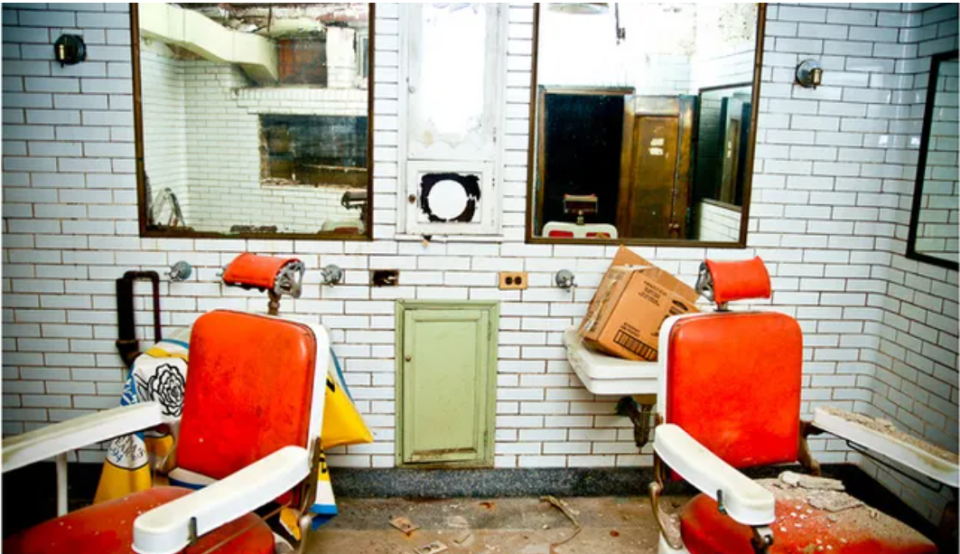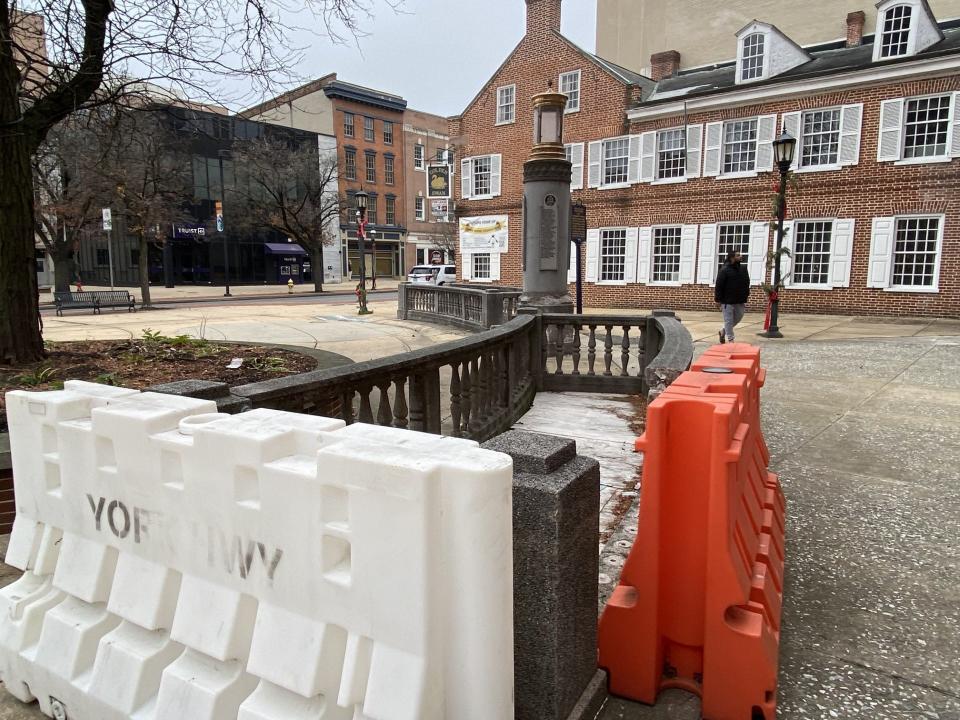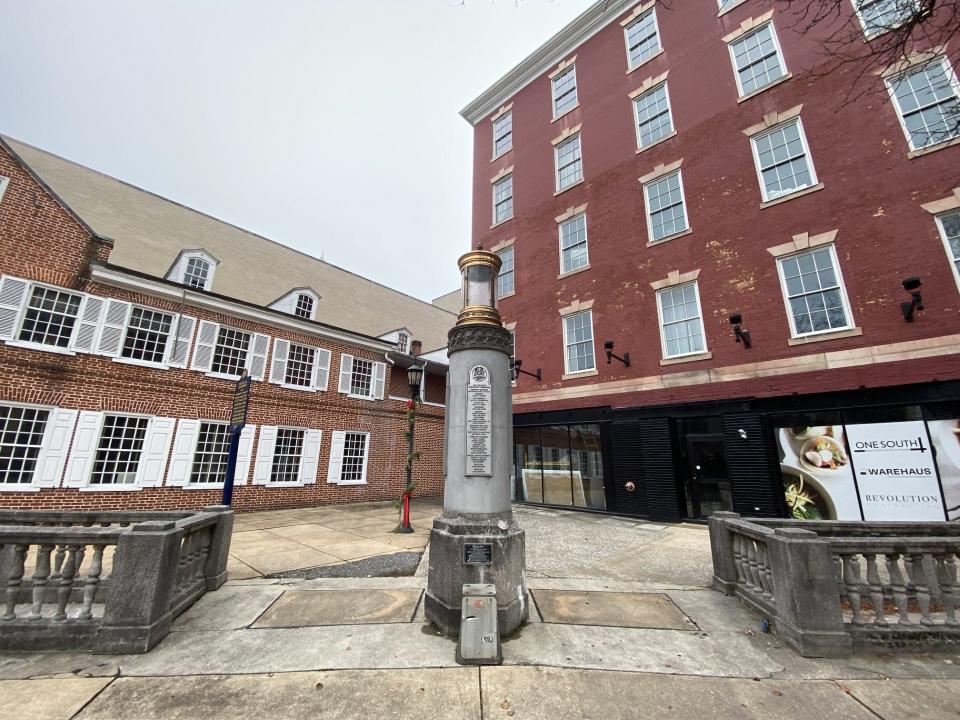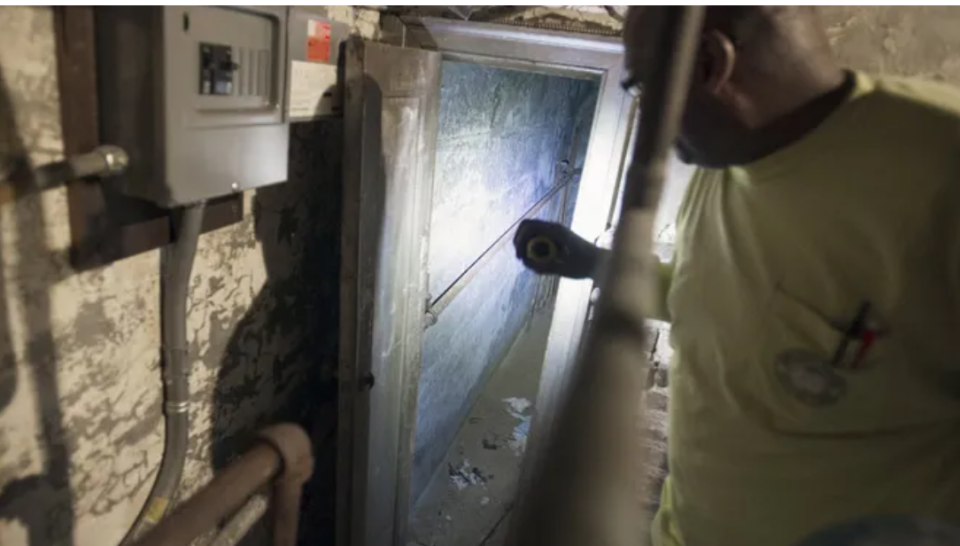Can York’s comfort stations gain relief? ‘There are no perfect options.’
The first nine years of Prohibition left downtown York visitors discommoded.
The 1920 ban on alcoholic beverages closed the bars that closed the restroom access. If you were in the downtown at certain times and you had to go, the normal options were few. Maybe none.
The urge was extreme to solve this problem, so in went subterranean comfort stations for men and women under Continental Square’s southeast angle in 1929. Barber chairs, lockers, a water fountain and a bathtub on the women’s side and all.
It did the job, except one evening that it was needed the most: V-J Day, the day of Japan’s surrender in World War II. Prohibition was long gone by 1945, and it was a time to celebrate, so those in the jam-packed square were, shall we say, well lubricated. That was so despite the fact that the bars were again closed for the celebration.
The city employees staffing the comfort stations were granted time off to celebrate. So the comfort stations were closed and the crowd, as the newspaper indicated, could not find a place to spell relief.
At the next city council meeting, Mayor John Snyder criticized the city’s park director’s decision to close the stations, sparking verbal brickbats.
Time passed, the crowds strolling the sidewalks thinned and the pressure to use the comfort stations lessened. In the late 1970s, they were closed.

In the 1990s, Mayor Charlie Robertson vowed to bring them back – a pledge that he kept. They were open off and on into the 21st century — available, for example, for Bike Night in 2009.
But in the past decade, the comfort stations have been closed, their steps filled with trash. Not long ago, the roof on one side partially caved in because of water seepage from the round planter above. In recent years, one of the banisters was damaged.
What could be done with this asset that some would say is the most unusual man-made artifact left to develop in York County. The comfort stations would appear atop the short list of features that York County can tout that few, if any, other cities can boast of.
York’s old and deteriorating Chestnut Street Prison and the long-closed Hex Murder House in southern York County rival the comfort stations on the curiosity list.
Any restoration project of the comfort stations would complement — in a subterranean way — the experience offered today in taking the elevator to the lounge atop the restored Yorktowne Hotel. With all the curiosity, albeit without the view.

ADA compliance possible
Several years ago, entrepreneur Toni Calderone had a plan. She owns One South Boutique Hotel and Venue, among other eateries and businesses under the One Hospitality York brand.
Her hotel offered an asset to the comfort stations, a connecting underground hallway. That feature would mark a costly item off the list — Americans with Disabilities Act compliance — in case, say, a restaurant would operate in the comfort stations’ space.
This time last year, she took to Facebook to say she had walked through the comfort stations with architects about three years before.
She developed a plan and budget and submitted it to the state for Redevelopment Assistance Capital Program funding.
“Sad to say, we didn’t receive the money to turn this treasure into something great for our city,” she wrote on Facebook. “BUT, if there are any investors out there who want to jump in, LETS GO. Be the change.”
Calderone operates the King George, a legal speakeasy under her Tutoni’s eatery. Speakeasies in the Prohibition days illegally provided alcoholic beverages. So her participation in the comfort stations project would stick with themes from that era.

What the city thinks
With all this said, what is the best thinking for the comfort stations? For now, the city’s plan is to essentially board them up to stop deterioration until a viable proposal emerges to make use of them. The railings will be removed and put into storage. The nearby planter will be removed to open up the often-crowded plaza for events.
The move is akin to what preservationists prescribed for Spring Grove’s Hoke House about a decade ago. Board it up to secure it against deterioration. Keep it intact until a plan emerged, which just happened this year with a project to relocate the 275-year-old stone building.
David Rudolph is electrical bureau/building maintenance superintendent for the city and has a close vantage point to understand this underground landmark. Here are his responses to five questions about the comfort stations:
Q. I understand that there is work planned involving the railings and the steps for both sides of the comfort stations. What is planned there in the short term?
A. There are no perfect options. The cost of restoring the comfort stations is prohibitive. Their condition makes them entirely unusable. Restoring them would also mean manning them from a perspective of security and cleanliness. This is an expense the city cannot sustain.
Meanwhile the banisters are in very poor condition and the staircases have gathered garbage. Removing the banisters and installing a weight-bearing concrete closure to encapsulate the comfort stations is a low-cost option that would open up space on the southeast corner of Continental Square, while preserving the comfort stations for a potential future restoration or alternative use.
The banisters will be kept in storage in case the city or another party is prepared to restore the comfort stations to their original form.
Q. You have said the comfort stations have a purpose in serving as the place where the electricity for the streetlights feed from. Can you explain this and other possible practical uses that would keep the comfort stations from being filled in or otherwise demolished?
A. There are no plans to demolish the comfort stations altogether. The possibility of reopening them if there is sufficient funding for restoring and manning them will exist.
In addition, electrical wiring in the comfort stations is part of the electrical system in the area. A hatch will be installed to allow for ongoing access for utility purposes.
Q. What would it take to reopen one or both sides of the comfort stations for their original use or for other purposes that have been suggested in the past — as an attraction, restaurant or museum? Is it even possible the comfort stations can be adapted for any use? Is there a possibility of dovetailing the comfort stations with the connecting OneSouth Boutique Hotel and its elevator to meet ADA compliance?
A. The cost was estimated to be $2 million in order to bring the comfort stations up to code, then there are the ongoing costs of security and cleanliness. The cost is only growing. We have considered an alternative like a restaurant connected to OneSouth Boutique Hotel with its elevator.
This would lessen the cost by making the comfort stations compliant with the Americans with Disabilities Act. Yet sufficient funding never came through.
Q. What interests you the most personally about the comfort stations — past, present or future?
A. They were a part of our history. They were built in 1929, when cities were the center of wealth. Unfortunately, that is no longer the case, making it hard for the city to commit to a restoration and manning of the comfort stations.
Q. Is there anything else that you’d like the public to know about the comfort stations?
A. I think we all feel a bit of nostalgia when we think of the comfort stations. They are a part of our history.
Importantly, our current plans to remove the banisters and close off the steps was arrived at as a cost-effective approach that, as I said, would open up space on Continental Square’s southeast corner for public use while preserving the station for a future restoration or alternate use.

Upcoming presentations
“Hometown History’s” Jamie Noerpel, Dominish Marie Miller and James McClure will present at an OLLI at Penn State York class about “Bridging the Susquehanna: Ice, Fire, Wind and Man Destroyed Four Spans, But Two Long Bridges Stand” at 3 p.m. Jan. 24. All six bridges represent chapters in the story of the river towns they connect and the wide Susquehanna that they span.
Jim McClure will present to an OLLI class on the topic “Slate-Rich Delta and the Welsh Who Worked Its Quarries” at 11 a.m. Jan. 29. He will tell how the Welsh presence helped shape this southeastern region of York County and many other interesting parts of Delta/Peach Bottom’s culture, religious scene and geography. To register for these classes and other Osher Lifelong Learning Institute classes, go to https://olli.psu.edu/york/courses.
Jim McClure is a retired editor of the York Daily Record and has authored or co-authored nine books on York County history. Reach him at jimmcclure21@outlook.com.
This article originally appeared on York Daily Record: Can York Pa.’s Continental Square comfort stations gain relief?

